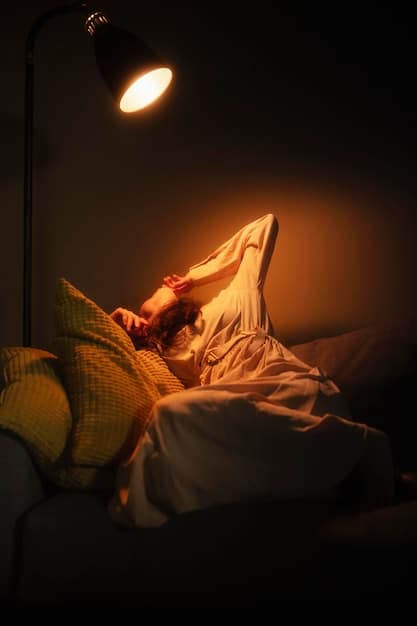The Science of Sleep: Understanding Your Sleep Cycles

The science of sleep involves understanding the cyclical patterns of sleep stages, including REM and non-REM sleep, to optimize physical and mental restoration while improving overall health and well-being.
Have you ever wondered what happens to your body and mind as you drift off to sleep? The science of sleep: Understanding your sleep cycles can unlock the secrets to better rest and improved health. Join us as we explore this fascinating realm!
Understanding the Basics of Sleep Science
The quest to understand sleep has intrigued scientists and researchers for decades. In order to effectively achieve the science of sleep: Understanding your sleep cycles, we must first start at its origins. Sleep is not simply a period of inactivity. It is a complex, dynamic process essential for physical and mental restoration.
Why Do We Need Sleep?
Sleep serves several vital functions. It allows the body to repair tissues, consolidate memories, and regulate hormones. Without enough sleep, our cognitive functions, mood, and physical health suffer.
- Physical Restoration: During sleep, the body repairs and rejuvenates itself, strengthening the immune system.
- Cognitive Function: Sleep is essential for memory consolidation and learning processes.
- Emotional Regulation: Sleep deprivation can lead to mood swings, irritability, and increased stress levels.
The need for sleep varies from person to person. While some can function well on six hours, others require eight or more to feel rested. Understanding your own sleep needs is the first step in optimizing your sleep health.
In essence, the science of sleep provides a framework for understanding how our bodies and minds benefit from rest, paving the way for strategies to improve sleep quality.
The Stages of Sleep: A Detailed Overview
Sleep is not a uniform state. It consists of several distinct stages. These stages cycle throughout the night, each playing a unique role in the restorative process. Knowing the science of sleep: Understanding your sleep cycles involves comprehending how sleep occurs in each stage.
Non-REM Sleep: Stages 1-3
Non-Rapid Eye Movement (NREM) sleep includes three stages. Each stage progressively deepens the state of rest.
- Stage 1: The transition from wakefulness to sleep. It is a light sleep stage where you may experience hypnic jerks.
- Stage 2: A deeper sleep stage where brain waves slow down. This stage prepares the body for deeper rest.
- Stage 3: The deepest stage of sleep, crucial for physical restoration and hormone regulation.
During NREM sleep, heart rate and breathing slow down. The body uses this time to repair tissues, build bone and muscle, and bolster the immune system.
The progression through these stages is vital for achieving deep rest and reaping the full benefits of sleep. By understanding these stages, we can better appreciate the complex nature of sleep and its impact on our health.

REM Sleep: The Realm of Dreams
Rapid Eye Movement (REM) sleep is the stage most associated with dreaming. It is an active sleep stage characterized by rapid eye movements, increased brain activity, and muscle paralysis. Grasping the science of sleep: Understanding your sleep cycles requires exploring REM sleep.
During REM sleep, the brain processes and consolidates memories, enhancing learning and cognitive function. This stage is also crucial for emotional processing and creativity.
- Memory Consolidation: REM sleep helps transfer short-term memories into long-term storage.
- Emotional Processing: The brain processes emotions, reducing stress and anxiety.
- Creativity: REM sleep fosters creativity and problem-solving abilities.
REM sleep typically occurs in cycles, with each episode lasting longer as the night progresses. Disruptions to REM sleep can lead to cognitive and emotional imbalances.
Understanding the realm of dreams and REM sleep provides insight into how sleep supports mental and emotional well-being. It highlights the importance of obtaining sufficient REM sleep for optimal cognitive function.
The Sleep Cycle: How Stages Interact
The sleep cycle is the sequence of sleep stages we move through each night. A typical sleep cycle lasts about 90 to 120 minutes. Understanding the science of sleep: Understanding your sleep cycles means assessing how all stages fit.
Each cycle consists of NREM sleep (stages 1-3) followed by REM sleep. As the night progresses, the duration of REM sleep increases while deep NREM sleep decreases.
Factors Influencing Sleep Cycles
Several factors can influence the length and quality of sleep cycles, including:
- Age: Sleep patterns change throughout life, with infants needing more REM sleep and older adults experiencing lighter sleep.
- Lifestyle: Factors like diet, exercise, and stress can impact sleep cycles.
- Environment: A comfortable and dark sleep environment promotes better sleep cycles.
Disruptions to the sleep cycle, such as frequent awakenings or inconsistent sleep schedules, can lead to sleep deprivation and its associated health problems.
Recognizing the rhythmic nature of sleep cycles underscores the importance of maintaining a consistent sleep schedule to support optimal rest and rejuvenation.

Tips for Optimizing Your Sleep Cycles
Optimizing your sleep cycles can lead to significant improvements in your physical and mental health. Creating healthy sleep habits supports the natural progression of sleep stages.
Here are some practical tips to enhance your sleep cycles:
- Maintain a Consistent Sleep Schedule: Go to bed and wake up at the same time every day.
- Create a Relaxing Bedtime Routine: Engage in calming activities like reading or taking a warm bath.
- Optimize Your Sleep Environment: Ensure your bedroom is dark, quiet, and cool.
- Limit Screen Time Before Bed: Avoid using electronic devices at least an hour before sleep.
These changes can positively influence your sleep cycles, helping you achieve deeper more restful sleep.
Incorporating these tips into your daily routine can optimize sleep by supporting the natural ebb and flow of sleep cycles. Embracing these practices can enhance your overall well-being.
Common Sleep Disorders and Their Impact
Sleep disorders can significantly disrupt sleep cycles and overall health. Conditions like insomnia, sleep apnea, and restless legs syndrome can impair the quality and quantity of sleep.
Understanding these disorders is essential for promoting better sleep health:
Insomnia
Characterized by difficulty falling asleep, staying asleep, or both. It can lead to daytime fatigue, irritability, and impaired cognitive function.
Management strategies include:
- Cognitive Behavioral Therapy (CBT): Addressing negative thoughts and behaviors about sleep.
- Relaxation Techniques: Practicing mindfulness or deep breathing exercises.
Sleep Apnea
A condition where breathing repeatedly stops and starts during sleep. It can lead to fragmented sleep, snoring, and increased risk of cardiovascular problems.
Treatment options:
- Continuous Positive Airway Pressure (CPAP): A device that helps keep airways open during sleep.
- Lifestyle Changes: Weight loss, avoiding alcohol before bed, and quitting smoking.
Addressing sleep disorders is essential for restoring healthy sleep cycles and preventing long-term health complications. Early diagnosis and treatment are key to improving sleep quality and overall well-being.
| Key Point | Brief Description |
|---|---|
| 😴 Sleep Stages | Includes NREM (1-3) and REM; each plays unique roles in restoration. |
| ⏰ Sleep Cycle | Averages 90-120 minutes; cycles through NREM and REM. |
| 🌙 Sleep Optimization | Consistent schedule, bedtime routine, optimized environment. |
| 🛏️ Sleep Disorders | Insomnia and sleep apnea disrupt sleep cycles; treatment is essential. |
Frequently Asked Questions (FAQ)
▼
Most adults need 7-9 hours, but needs vary. Factors like age, genetics, and activity levels impact sleep duration. Listen to your body and adjust accordingly to improve rest.
▼
Establish a relaxing routine, reduce screen time before bed, and ensure your sleep environment is dark, quiet, and cool. Try deep breathing to relax and prepare for rest.
▼
Regular exercise enhances sleep quality by reducing stress and improving overall health. Avoid intense exercise close to bedtime. Morning workouts often lead to deeper rest.
▼
Yes, long or late-day naps can disrupt sleep cycles. Keep naps short (20-30 minutes) and take before mid-afternoon not to interfere with your nighttime sleep.
▼
Sleep trackers can be useful for monitoring sleep patterns, but they’re not always 100% accurate. Combine tracker data with your personal experience for a comprehensive view.
Conclusion
Understanding the science of sleep: Understanding your sleep cycles provides valuable insights into enhancing the way we live. By learning about sleep stages, optimizing sleep habits, and addressing sleep disorders, you can improve your overall well-being and unlock your body’s full potential.





